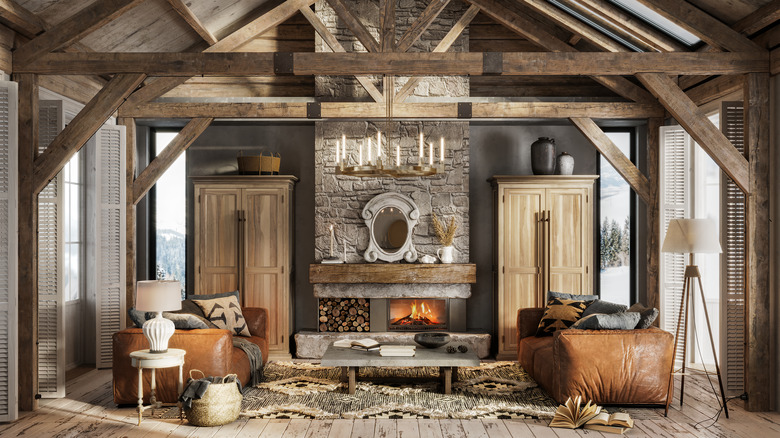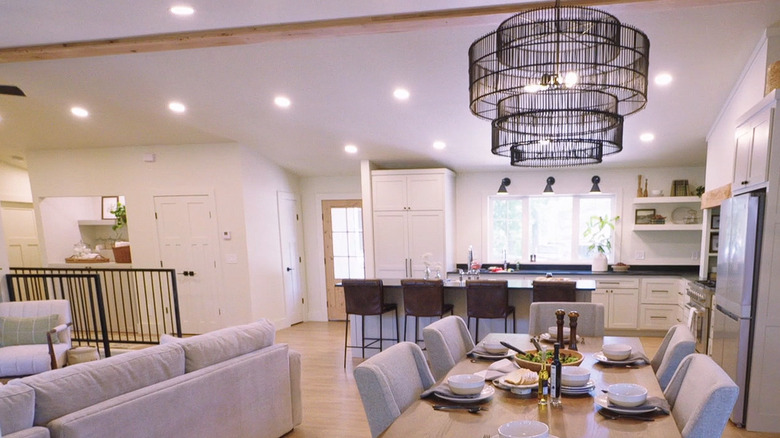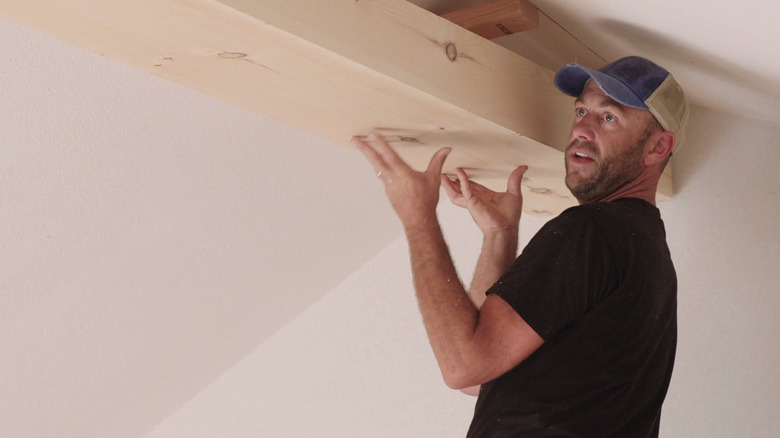Jenny Marrs Explains How To Bring A Touch Of Cozy Cabin Vibes Into Your Home
When Whitney, a grandmother living on her own, asked Jenny and Dave Marrs to help her renovate the lakeside home she had just bought, the "Fixer to Fabulous" hosts had a lot to work with. Previous owners had stopped just short of really integrating the home with its picturesque natural surroundings. Team Marrs put a lot of work into fixing that, adding outdoor living features and warmer elements inside. Perhaps the simplest touch was an exposed beam in the living room that brought the somewhat sterile atmosphere down to earth.
"I think it just needs some texture in here," Jenny Marrs told Whitney. The room was described as an "open canvas" that just needed some warmth and more personality. Jenny is hardly the only HGTV designer to champion beams; for example, David Bromstad enthusiastically recommends using beams in your home design. The beam contributed enormously to grounding the redesigned room. "I absolutely love it," Whitney said at the reveal. Jenny added they chose the beam because they "really wanted this whole house to just feel a little bit more cabin-y."
Exposed beams can add charm and those cozy cabin vibes to many homes, from hillside lake retreats to suburban new construction. The typical installation is a stained wood beam in a rustic home — or one that aspires to be rustic — with vaulted ceilings. However, nothing is stopping you from painting the beam or installing it in a first-floor den with low ceilings.
Faux wood, faux beam, or both?
Exposed beams are usually a trick of the carpentry trade, a floating box of wood or polyurethane that looks like a single piece of timber. But, does a term like "faux beam" mean that the wood is fake, that the beam itself is fake, or that both are? Occasionally you'll hear the term applied to lightweight poly beams that are manufactured to look like wood, but for the most part what is "faux" is the overall beam itself.
When you see an exposed beam, there are three possibilities: it is a solid wood timber, either structural or a nonfunctional decoration; it is a composite or poly look-alike; or it is constructed on-site from long boards carefully joined to look like a single piece. There are other possibilities, like structural steel beams, but those are unusual and often impart a completely different, more industrial vibe.
Most commonly installed are box beams or ones made from composite materials. Sometimes they're milled to look more refined. Others are designed to look more rustic, like reclaimed wood from 19th century mills. Some are even custom-made from those very reclaimed timbers. Box beams are more expensive than their solid-wood namesakes at around $28 per linear foot but can go as high as $48 per foot for premium materials in some areas, while polyurethane beams average about $18 per foot.
Even better than the real thing
It's strange to say, given that exposed beams are designed to suggest the real thing, but being "real" alone won't make an exposed timber do a better job of adding warmth to your home or integrating it with natural surroundings. The fact that it's holding up the roof or a second floor isn't what makes the exposed wood feel cozy or rustic. And, actual exposed beams aren't necessarily aesthetically pleasing. Sometimes box beams are constructed specifically to hide unsightly real wood timbers. Of course, the faux beams should look as real as possible, and Jenn Todryk of "No Demo Reno" has some great tips for making a faux beam look real.
It's a happy accident when exposing actual beams works as well as adding fake ones. This is especially true in new construction, where exposed beams are more likely to be functional rather than aesthetically pleasing. The act of exposing them often even compromises some aspect of the construction itself, like the ability to add insulation for temperature control or soundproofing.
Exposed structural wood should suggest age, and antiquity has a kind of built-in authenticity. But, this effect is easy to undermine. Consider exposed joists from the floor above that might look pleasantly vintage. If you've also exposed plywood or OSB subfloor between the joists, it won't have the same effect as old plank subfloor boards would. Often, the quickest path to the old and authentic is via the new and fake.


